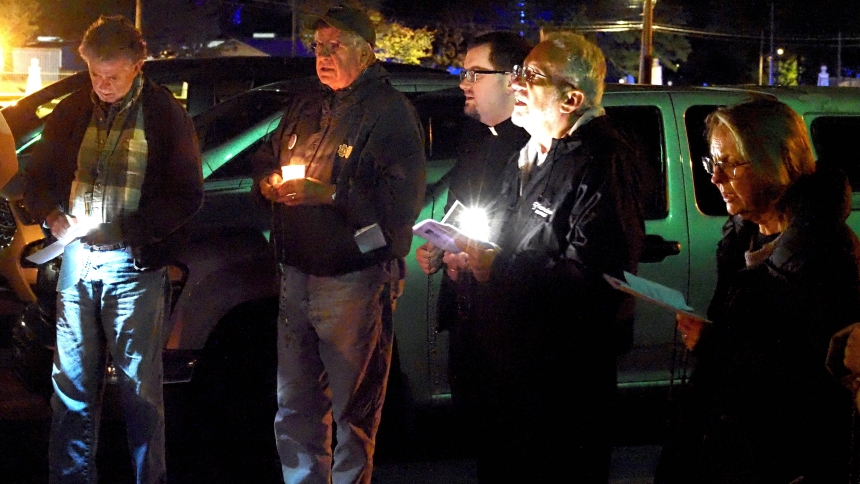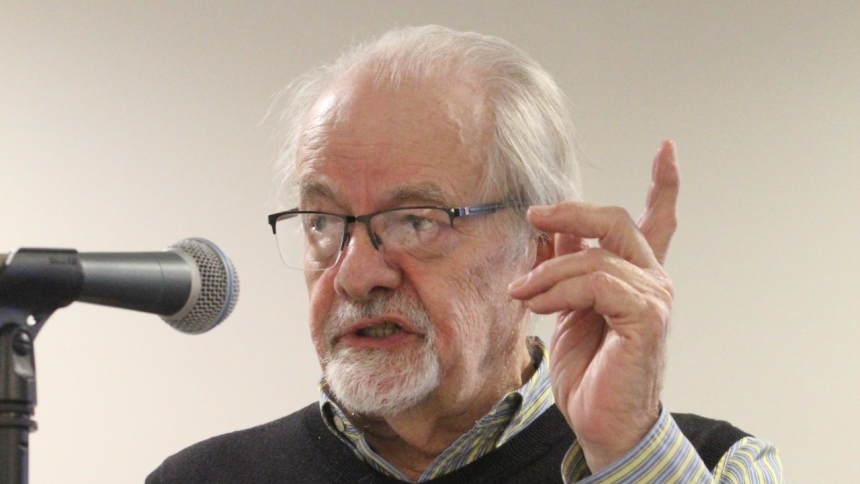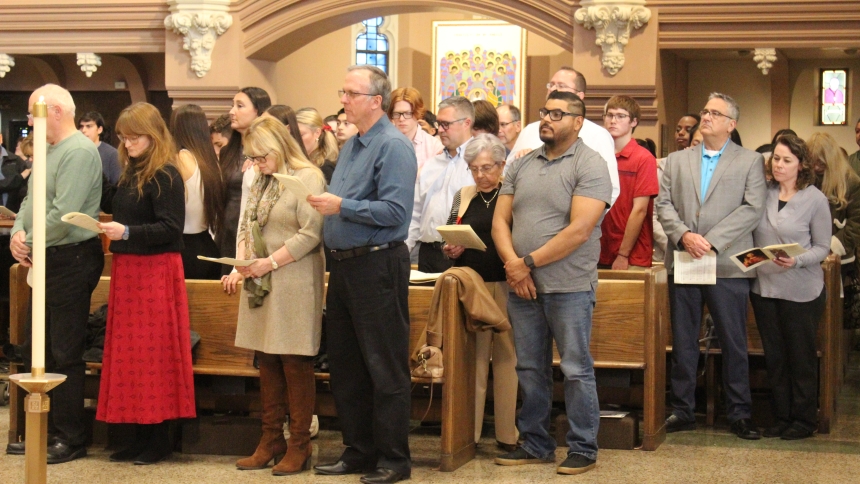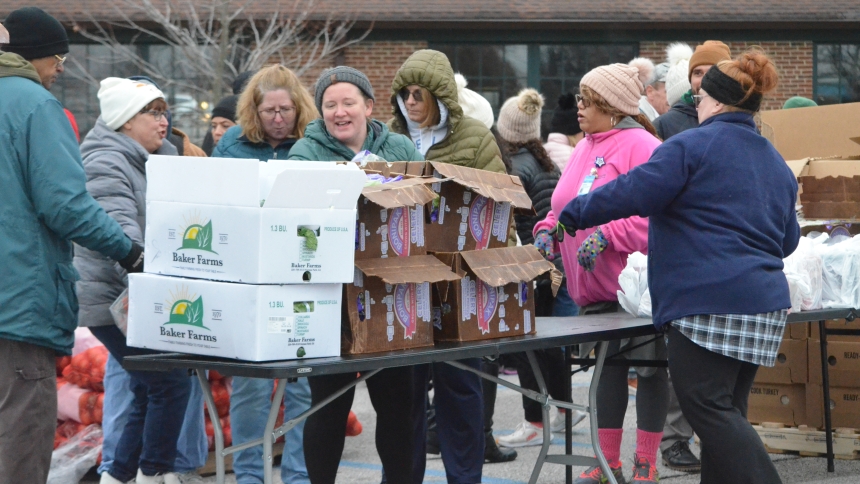
MICHIGAN CITY– As the clock struck midnight on Oct. 10, the World Day Against the Death Penalty had just started. Shortly thereafter, within the walls of the Indiana State Prison in Michigan City, the process to execute death row inmate Roy Lee Ward by lethal injection had begun. At 12:33 a.m. CDT, Ward was dead.
Ward was convicted of the 2001 rape and murder of 15-year-old Stacy Payne in Spencer County. Authorities said Ward attacked the girl with a knife and a dumbbell in her family’s southern Indiana home. He was the third ISP inmate executed in less than a year. Since 1897, 97 inmates have been executed in the state’s prison – 26 since the reinstatement of the death penalty in 1977.
Earlier in the evening, outside the prison walls, nearly 40 people gathered in a dimly lit parking lot for a prayer vigil. The vigil was organized by the Diocese of Gary’s Office of Pro-Life Activities with Bishop Robert J. McClory and Father Rick Holy leading the group in the Sorrowful Mysteries of the Rosary and a prayer service.
“When the state resumed the death penalty, we resumed prayer vigils to draw attention first and foremost to the fact that this is happening again- that we are executing death row inmates,” said Father Holy, director of the Office of Pro-Life Activities.
“What we are trying to do is not deny the horrific nature of the things they have done but to point out that his life still has value – maybe not in the outside world, but inside those walls. We can have justice without having death. We don’t need to add one more death to what has been a very horrible, sorrowful situation.”
Father Holy pointed to St. Paul, who murdered many Christians. “He repented, he converted, he encountered Jesus Christ, and his life changed and went on to be the greatest Christian evangelist.”
The vigil wasn’t to focus strictly on abolishing the death penalty and Ward, but also to pray for the victims of crime and their families.
“We certainly acknowledge the devastating pain and loss that Stacy’s family experienced through the horrific murder that she experienced, while at the same time we’re here to give witness to the value of all human life,” said Bishop McClory.
The bishop referenced Pope Leo XVI’s recently released Apostolic Exhortation “On Love for the Poor” and the need to extend the “arms of love as widely as we can.”
“It reminds us that the Church is at Her best when we continue to expand the arms of love that we have,” said Bishop McClory. “That love extends to Stacy’s family. That love extends to those whose lives could be taken away through the death penalty as well.”
He continued, “We pray today that life and the Gospel of life will be advanced. We pray for an end to the death penalty and an end to violence as a means of solving our problems. We pray for all those affected victims of violent acts.”
Roseann Kouris, a member of the Office of Missionary Discipleship and Evangelization, reflected on the importance of participating in the vigil.
“It is important to be in solidarity with those facing death, no matter the reason,” she said. “Their eternal destiny is looming and we, as followers of Christ, need to be with them, as the situation allows, to offer our prayers. Secondly, our prayers are for a renewal of society where all life is held sacred.”
Kouris also acknowledged the controversial nature and clarified the historical justification of the death penalty as a means to protect society.
“Those conditions mostly do not exist now, given the modern means of imprisonment. We can protect society from dangerous offenders without the need to kill them,” she stated.
Kouris shared how working with families of victims who have been dragged through years of legal proceedings waiting for the death penalty to be applied to the criminal, reliving the situation over and over, doesn’t bring closure.
“By the time any execution is ordered, the families tend to have switched to a more merciful view, preferring a life sentence and offering forgiveness for the crime,” she said.
SueZann Bosler, of Miami, Fla., knows this all too well.
On Dec. 22, 1986, in Florida, Bosler and her father, Rev. Billy Bosler, were attacked by a man with a knife in the parsonage next to the church where he was minister. Despite several stab wounds, including one to her head, she survived, but her father did not.
“I was killing myself,” confessed SueZann Bosler. “I found every excuse not to forgive him.”
She admitted it took years before she shouted out to her assailant in court, “I forgive you.”
“It was the most beautiful, angelic experience of my life,” she said.
SueZann Bosler is a co-founder of a group called Journey of Hope, from Violence to Healing.
Boslern recalled a debate she and her father had about the death penalty and if anything should happen, he didn’t want the person to receive the death penalty. “It was almost prophetic.”
She added, “Dad’s favorite hymn was 'Let There Be Peace on Earth and Let It Begin with Me.” It’s got to begin with each and every one of us in our own way.”
First-year law students Luca Tzimas and Jack Puricelli joined other University of Notre Dame students at the vigil. Puricelli, a first-year University of Notre Dame law student, felt that as a Catholic, he was obligated to attend the vigil.
“If you believe in life, even if the person has committed great wrongs, they shouldn’t be killed for it,” he said. “Life in prison is death enough. Why take a life? Theologically, morally, and practically, there’s no reason he has to die. An eye for an eye and a tooth for a tooth was fulfilled on the cross. We don’t live under that law anymore.”
As light from candles and cellphones pierced the darkness of the parking lot, Puricelli feels prayer vigils help bring light to the darkness of executions and hope that one day executions will be abolished.
“If there’s not the eternal hope, then why are we here?” he said.
Caption: Deacon Tom Gryzbek (right) leads a group of nearly 50 people in one of the Sorrowful Mysteries outside of the Indiana State Prison Thursday evening prior to the execution of Roy Lee Ward. (Deacon Bob Wellinski photo)



